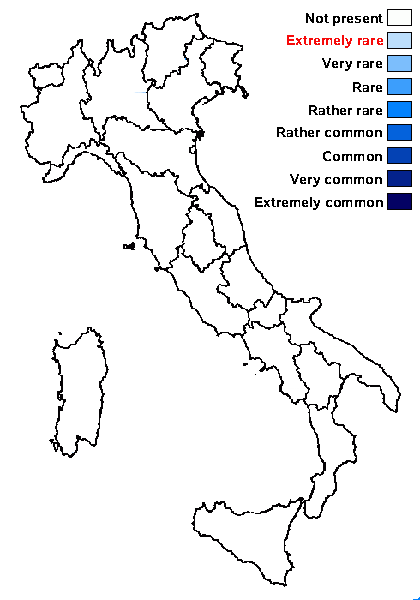Rinodina llimonae Giralt & Etayo
in Giralt & Mayrhofer, Bibl. Lichenol., 57: 143, 1995
Synonyms:
Distribution:
Description: Thallus crustose, episubstratic, smooth, granulose or rimose-areolate, whitish to pale grey, dull, without an evident prothallus, usually forming large patches. Apothecia lecanorine tending to become cryptolecanorine, immersed to finally sessile, (0.5-)0.7-1(-1.2) mm across, with a dark brown to black, epruinose, flat to finally strongly convex disc, an entire, thin, finally often excluded thalline margin, and a usually paler parathecial ring becoming excluded in older apothecia. Thalline exciple with a well-developed, (40-)50-70(-90) µm thick cortex reacting I-; proper exciple thin; epithecium dark brown, K-; hymenium colourless, 70-100 µm high, K/I+ blue; paraphyses 1.5-2.5 µm thick at mid-level, the apical cells 3-6 µm wide; hypothecium colourless. Asci 8-spored, narrowly clavate to clavate, the K/I+ blue tholus penetrated by a faintly amyloid apical cushion with parallel or diverging flanks, the wall K/I-, surrounded by a K/I+ blue outer layer, Lecanora-type. Ascospores 1-septate, pigmented, broadly ellipsoid, Dirinaria-type, (13-)15-19 x (6.5-)7-9(-11) µm, with a smooth to warted wall, swollen around the septum after pre-treatment with K, the torus poorly developed, the ontogeny of type B (apical thickenings visible before the insertion of the septum). Photobiont chlorococcoid. Spot tests: thallus and medulla K-, C-, KC-, P-, UV-. Chemistry: without lichen substances.Note: a mainly Mediterranean-montane, rare species, hitherto known only from Spain, mainly growing on conifers (Abies, Juniperus). To be looked for in the mountains of Mediterranean Italy.
Growth form: Crustose
Substrata: bark
Photobiont: green algae other than Trentepohlia
Reproductive strategy: mainly sexual

Predictive model
Growth form: Crustose
Substrata: bark
Photobiont: green algae other than Trentepohlia
Reproductive strategy: mainly sexual

Predictive model
 Index Fungorum
Index Fungorum
 GBIF
GBIF

